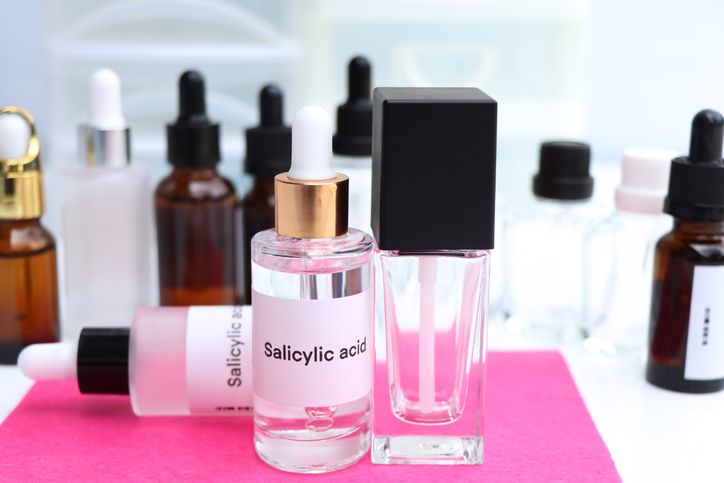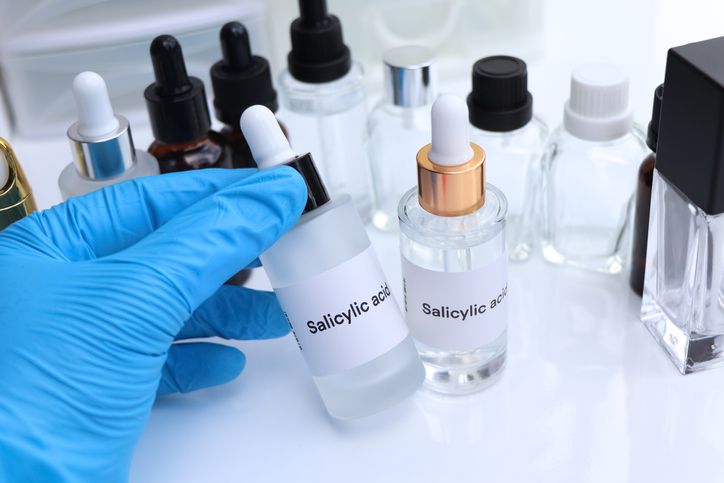- Home
- Trend
- Weight Loss Strategies
- Acne Tips
- Hair Health Information
- Blemish Removal Tips
- Acne Scar Removal Tips
- Muscle Building Techniques
- Intimate Care Tips
- Postpartum Intimate Care
- Eye Bags Wiki
- Tips for Face Slimming
- Secret of Permanent Hair Removal
- Breast Enlargement Tips
- Cure to Snoring
- Marionette Lines
- Skin-Tightening Secrets
In recent years, acid-based skincare products have grown in popularity, with many people using them to help maintain healthy skin. Among them, salicylic acid stands out for its powerful exfoliating effects and ability to boost skin renewal, making it highly favored for addressing various skin issues. But how exactly should we use salicylic acid products? What are their true benefits—and potential side effects? And is it suitable for everyone? This article answers all your questions.
What is Salicylic Acid?

Salicylic acid is a common ingredient in skincare. It’s also known as beta-hydroxy acid (BHA) or ortho-hydroxybenzoic acid. Interestingly, salicylic acid was originally derived from willow bark, which is why it's sometimes called “willow acid.” Over time, researchers also found it in sweet birch, wintergreen leaves, and even ginseng. Today, it’s mostly synthesized in labs for cosmetic use.
Its chemical structure is similar to acetylsalicylic acid—commonly known as aspirin. Salicylic acid contains a benzene ring with adjacent hydroxyl and carboxyl groups, giving it excellent oil solubility. This allows it to penetrate deeply into the skin and pores, making it effective for clearing clogged pores, blackheads, acne, and more.
What’s the Difference Between Salicylic Acid (BHA) and Glycolic Acid (AHA)?

When talking about BHA, it’s natural to think of AHA—another popular acid in skincare. So what sets them apart?
AHA refers to a family of water-soluble acids like mandelic acid, citric acid, malic acid, and lactic acid. Chemically, AHAs have a linear structure and lack a benzene ring, making them more water-soluble but less oil-soluble than BHAs. Despite this, AHAs are also effective for exfoliating and improving skin texture.
In theory, AHAs—thanks to their small molecules and water solubility—can penetrate deeper into the skin. In contrast, BHAs are more lipophilic, allowing them to act more effectively on the skin's surface. Thus, BHA is often used for surface-level issues like exfoliation and acne, while AHA is better suited for deeper concerns like photoaging.
免費體驗
Acne Treatment
1 Minute Self-Registration
Date should not be before minimal date
What Are the Benefits of Salicylic Acid?
i. Exfoliation
The outermost layer of skin, the stratum corneum, protects underlying tissue. Normally, it renews itself about every 28 days as dead cells shed and new ones rise to the surface. But with age and environmental factors, this process slows, leading to buildup and thickened skin.
Salicylic acid softens and removes these dead cells chemically, leaving your skin smoother and more refined.
ii. Clears Blackheads, Whiteheads & Acne
Your skin is covered in sebaceous glands that secrete oil to keep it moisturized. However, excess oil can mix with dirt and clog pores, leading to blackheads, whiteheads, and pimples.
Salicylic acid dissolves these blockages thanks to its oil solubility, deeply cleaning pores and preventing future breakouts. Because its chemical structure is similar to aspirin, it also helps reduce inflammation from acne.
iii. Brightens Skin Tone
By accelerating dead skin cell turnover, salicylic acid can brighten dull skin and even out skin tone. Some studies also suggest it helps inhibit melanin production, reducing hyperpigmentation.
iv. Fades Dark Spots
High-concentration salicylic acid (around 50%) can fade freckles, sunspots, and melasma. It’s often used in chemical peels and professional treatments. But due to its strong acidity, this level should only be applied by trained dermatologists or aestheticians to avoid injury.
v. Reduces Fine Lines
Studies show salicylic acid stimulates the production of collagen and mucopolysaccharides in the dermis. With regular use, it can boost skin firmness and elasticity, helping to reduce fine lines and delay signs of aging.
What Concentration of Salicylic Acid is Effective?
Anyone who’s tried salicylic acid knows that concentration matters. Too high, and it can irritate the skin; too low, and it might not work.
For exfoliation and other benefits, the concentration should be at least 0.5%. Ideally, it should range from 1% to 2%. The pH of the product also affects its potency—a pH between 3.5 and 4 is considered optimal.
Because salicylic acid is classified as a “medicated cosmetic,” legally sold products must meet safety regulations. As long as you follow usage instructions, it’s generally safe to use.
4 Common Side Effects of Improper Salicylic Acid Use
Despite its many benefits, improper use of salicylic acid can lead to side effects—or in rare cases, even toxicity.
i. Skin Irritation or Allergic Reaction
Some users experience redness, swelling, itching, pain, or even a burning or stinging sensation. These are signs of irritation or an allergic reaction, especially common with acid-based products.
ii. Dryness or Peeling
Even without an allergic response, some people experience dry or peeling skin. This is normal, especially for first-time users, as the acid accelerates cell turnover.
iii. Purging (Breakouts)
Initial breakouts can occur as the acid pushes trapped oil and debris to the surface. This “purging” phase usually lasts 1–2 weeks. However, if acne worsens or persists, seek medical advice.
iv. Salicylic Acid Toxicity
While rare, using high-concentration salicylic acid over large areas and for prolonged periods can lead to toxicity. If applied to over 30% of the body, it can cause symptoms like rapid breathing, ringing in the ears, dizziness, nausea, or diarrhea.
免費體驗
Acne Treatment
1 Minute Self-Registration
Date should not be before minimal date
What to Consider When Buying Salicylic Acid Skincare Products
i. Concentration
Avoid overly high concentrations, especially if you’re new to salicylic acid. Start with low doses and increase gradually as your skin builds tolerance.
ii. pH Level
Products with lower pH are more potent but also more irritating. Milder products may have less visible effects, but are gentler on sensitive skin. Choose a product that balances efficacy with skin compatibility.
4 Tips to Avoid Damaging Your Skin with Salicylic Acid
i. Patch Test First
If you have sensitive skin or are new to acids, test the product on a small area—like the neck, behind the ear, or inner arm—before applying it to your face.
ii. Limit Contact Time
The longer salicylic acid sits on your skin, the more likely it is to irritate it. Avoid leaving it on for too long, especially for first-timers or those with sensitive skin.
iii. Don’t Overuse It
Excessive exfoliation can damage your skin barrier, leading to inflammation, dryness, or acne. Limit use to once per week, or once every 2–4 weeks for sensitive skin.
iv. Follow Up With Proper Aftercare
After using salicylic acid, your skin will be more sensitive to UV rays. Apply sunscreen diligently to prevent damage and premature aging. Also, focus on hydration—salicylic acid can dry out the skin, so using moisturizers can help stabilize and protect your skin barrier.
Want to Fight Acne But Find Salicylic Acid Too Harsh? Try Perfect Medical’s Acne Treatment!
While salicylic acid can help with acne, it may not be suitable for everyone—especially those with sensitive skin. If you’re looking for a gentler yet effective solution, consider Perfect Medical’s Acne Treatment.
The Acne Treatment uses advanced dual-spiral suction drainage technology. During the treatment, one tube utilizes vacuum dermabrasion to deeply cleanse the skin, gently and quickly removing oil, impurities, whiteheads, and blackheads from the pores. At the same time, another tube delivers a proprietary medical-grade serum into the deeper layers of the skin, helping to calm inflammation while also regulating excess oil production. This dual action effectively improves acne conditions and restores skin to a healthier state.
Additionally, the treatment helps to reactivate collagen regeneration in the skin, which can fade acne scars and smooth out pitted areas.
Currently, Perfect Medical is offering a free trial of the Acne Treatment. Just click the link below to schedule your complimentary session—don’t hesitate!
Free Trial: Perfect Medical Acne Treatment免費體驗
Acne Treatment
1 Minute Self-Registration
Date should not be before minimal date
FAQ

What is salicylic acid?
Salicylic acid (BHA) is a type of beta-hydroxy acid. It was originally derived from willow bark, which is why it's sometimes referred to as willow acid. As a fat-soluble acid, it can easily penetrate the skin’s surface to deeply clean pores and target issues like clogging, blackheads, whiteheads, and acne.
What are the benefits of salicylic acid (BHA)?
Salicylic acid has been used to treat skin concerns for over 2,000 years, highlighting its powerful effectiveness. One of its main benefits is promoting the shedding and renewal of dead skin cells. It also helps reduce acne, minimize blackheads and whiteheads, brighten skin tone, and fade dark spots.
Can people with sensitive skin use salicylic acid products?
Because salicylic acid is an acidic ingredient, it may irritate the skin. Therefore, it's generally not recommended for sensitive skin types. If you do wish to try it, opt for products with a lower concentration. If you experience redness, swelling, stinging, or itching, discontinue use immediately.
What concentration of salicylic acid is effective?
A concentration of at least 0.5% is needed for salicylic acid to be effective. Ideally, look for products containing 1% to 2% for better results. Also, the pH level of the product matters—formulas with a pH between 3.5 and 4 are considered most effective.
How often should I use salicylic acid?
Because salicylic acid can be irritating, it shouldn’t be used too frequently. Once a week is generally recommended. For those with sensitive skin, once every two weeks or even once a month is more appropriate.









